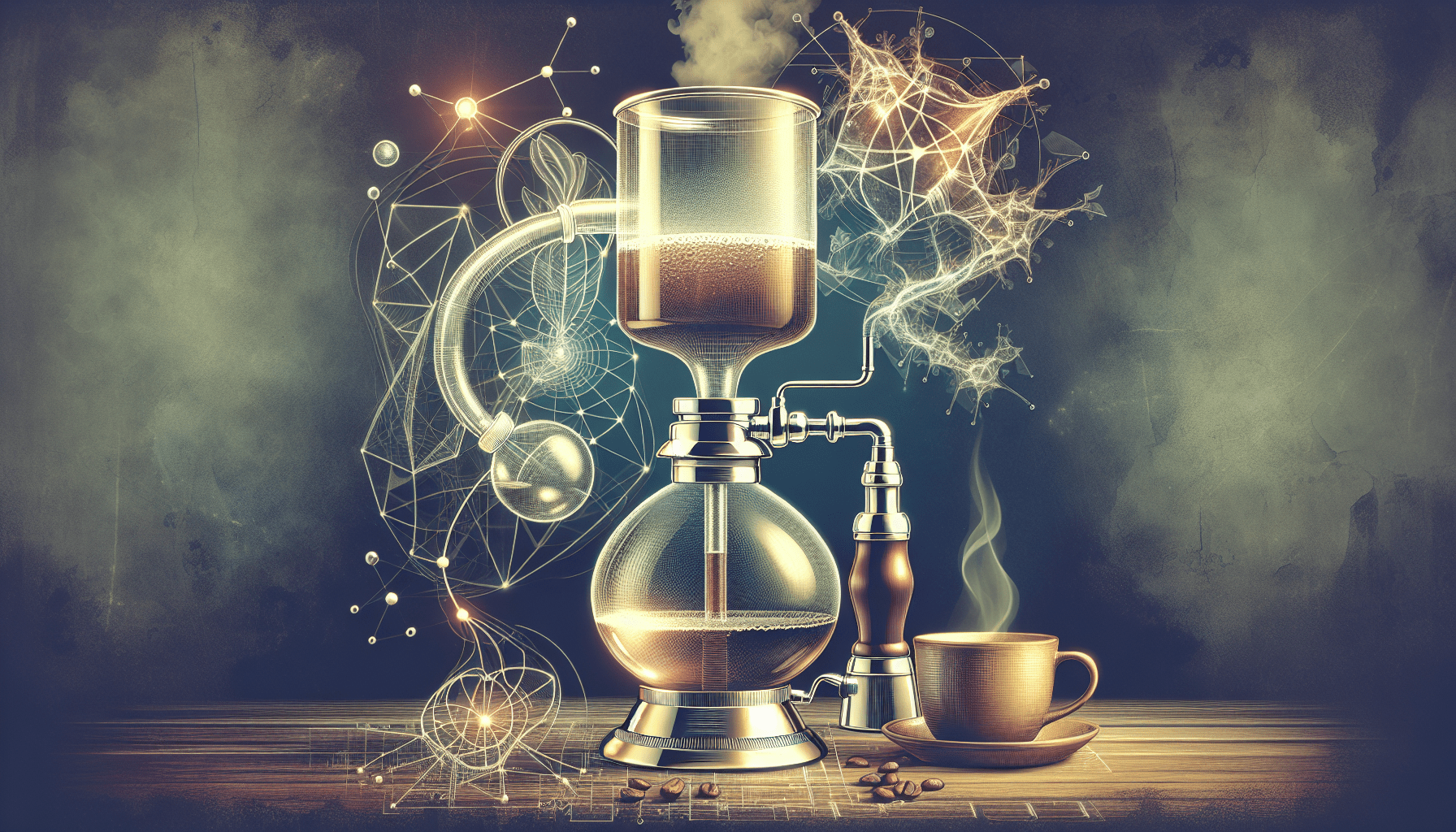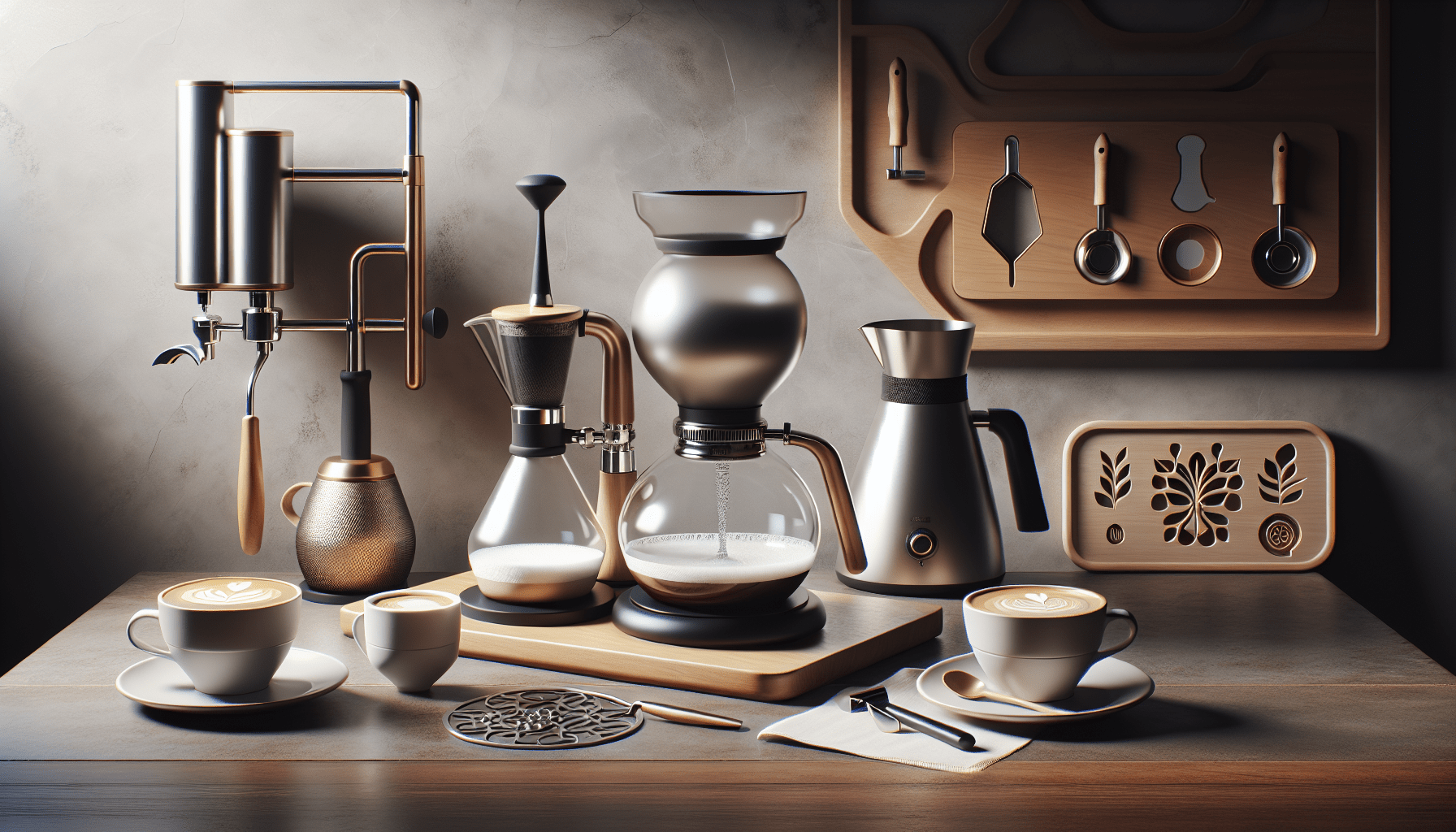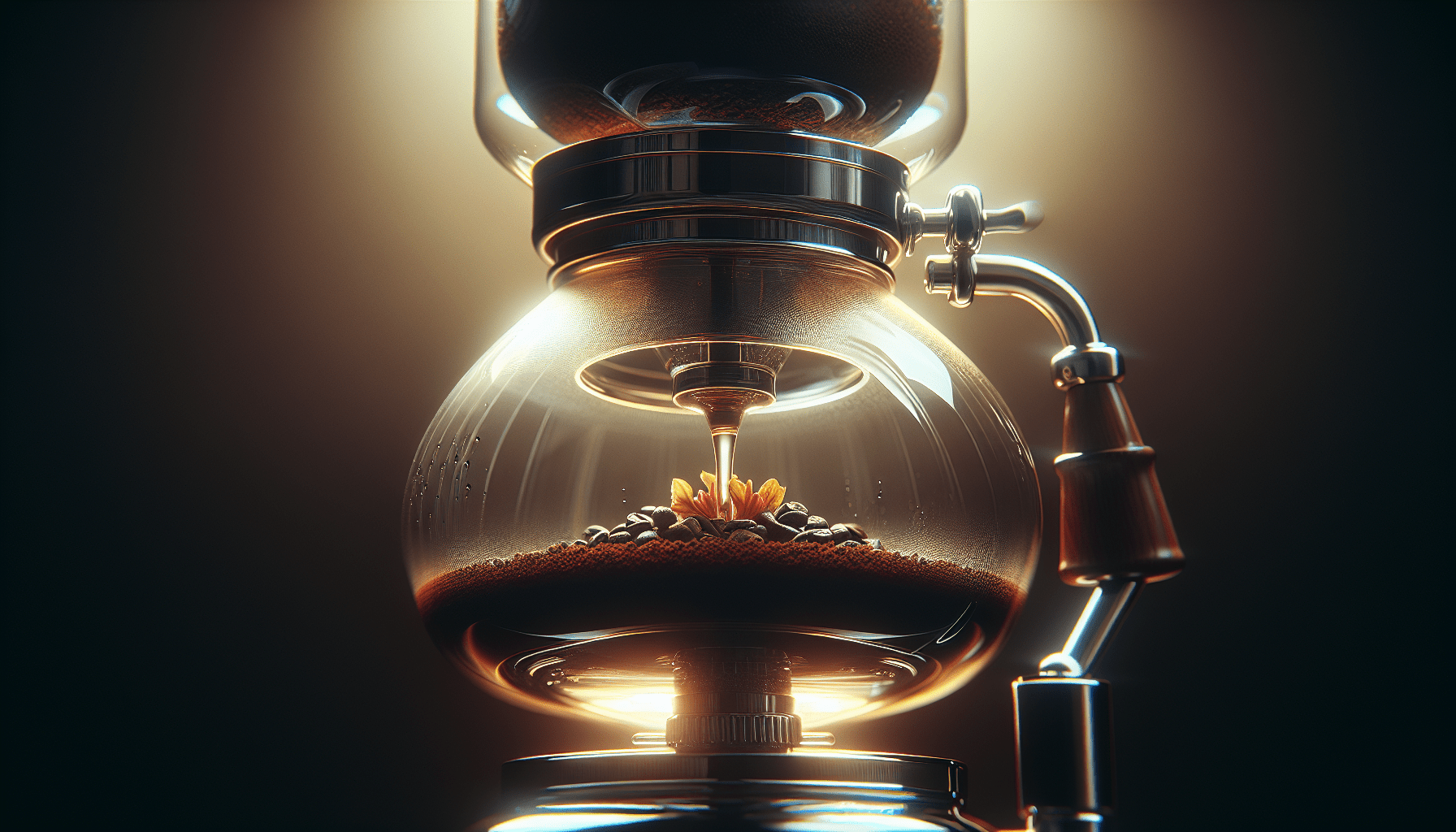Imagine waking up to the enticing aroma of freshly brewed coffee, the whole house infused with its rich fragrance. But have you ever wondered how it’s made? Introducing the siphon coffee maker, a fascinating brewing method that combines science and artistry to create the perfect cup of coffee. This unique contraption will transport you to a world where coffee-making is a spectacle, capturing the attention of anyone lucky enough to witness its mesmerizing process. So, sit back, grab a cup of joe, and let’s explore the wonders of the siphon coffee maker.
Definition
Explanation of siphon coffee maker
A siphon coffee maker, also known as a vacuum coffee maker or a syphon coffee maker, is a unique brewing device that uses a combination of vapor pressure and vacuum suction to extract the full flavor and aroma of coffee beans. It consists of two chambers, a top and a bottom chamber, which are connected by a siphon tube. The top chamber holds the coffee grounds, while the bottom chamber is filled with water. By heating the bottom chamber, the water rises to the top, creating a vacuum effect that draws the brewed coffee back down to the bottom chamber through a filter. This process results in a smooth and rich cup of coffee that is often hailed for its clean and vibrant taste.
Components
Top chamber
The top chamber of a siphon coffee maker is where the coffee grounds are placed. It is usually made of glass and is designed to be transparent, allowing the user to observe the brewing process. The size of the top chamber can vary depending on the capacity of the coffee maker.
Bottom chamber
The bottom chamber of a siphon coffee maker is where the water is heated and stored. It is also typically made of glass and has a larger capacity than the top chamber. The bottom chamber is equipped with a burner or heat source that provides the necessary heat for the brewing process.
Siphon tube
The siphon tube is a crucial component of the siphon coffee maker, as it connects the top and bottom chambers and allows the brewed coffee to flow back down. It is usually made of glass or metal and is designed to withstand high temperatures. The length of the siphon tube can vary, depending on the size of the coffee maker.
Filter
The filter is responsible for separating the coffee grounds from the brewed coffee as it flows back down to the bottom chamber. It is usually made of cloth or metal and is placed at the end of the siphon tube. The type of filter used can affect the clarity and flavor of the final brew.
Burner or heat source
The burner or heat source is an essential component of the siphon coffee maker, as it provides the heat necessary for the brewing process. It can vary in design, ranging from traditional alcohol burners to electric or stovetop heating elements. The choice of burner or heat source can impact the brewing time and temperature control.
How Does It Work?
Step-by-step process of making coffee with a siphon coffee maker
-
Begin by assembling the siphon coffee maker. Place the filter at the end of the siphon tube and secure it in place.
-
Fill the bottom chamber with cold water up to the desired level, taking into consideration how much coffee you want to brew.
-
Grind your coffee beans to a medium-coarse consistency and add them to the top chamber of the siphon.
-
Light the burner or heat source underneath the bottom chamber and wait for the water to heat up. As the water heats, it will rise to the top chamber, mixing with the coffee grounds.
-
Stir the coffee grounds gently to ensure an even extraction and prevent any clumping or uneven saturation.
-
Allow the coffee to brew for a few minutes, usually between 2 to 4 minutes, depending on your preference and the coffee beans you are using.
-
After the brewing time, remove the heat source and watch as the brewed coffee is drawn back down to the bottom chamber, passing through the filter and leaving behind the coffee grounds.
-
Once the coffee has fully descended to the bottom chamber, carefully remove the top chamber, separating it from the siphon tube.
-
Pour the freshly brewed coffee into your cup and enjoy its rich aroma and complex flavors.
Benefits
Enhanced flavor
One of the main benefits of using a siphon coffee maker is the enhanced flavor it produces. The brewing process allows for a full extraction of the coffee oils and flavors, resulting in a smooth and well-balanced cup of coffee. The use of a vacuum also prevents over-extraction, ensuring that the coffee is not bitter or burnt.
Brewing precision
Siphon coffee makers provide precise control over the brewing variables, such as water temperature and extraction time. This level of control allows coffee enthusiasts to experiment with different brewing techniques and adjust the brewing parameters to achieve their desired taste profile.
Visual appeal
Siphon coffee makers are not only functional brewing devices but also aesthetically pleasing. The transparent chambers and mesmerizing brewing process make for a visually captivating experience. Brewing coffee with a siphon coffee maker can be a delightful spectacle, especially for those who appreciate the art and science of coffee.
Conversation starter
Siphon coffee makers often spark curiosity and conversation due to their unique design and brewing method. Whether used at home or in a coffee shop, the sight of a siphon coffee maker in action can attract attention and serve as a great conversation starter among coffee enthusiasts.
History
Origins of siphon brewing
The origins of siphon brewing can be traced back to the 1830s, with the invention of the vacuum coffee maker by a Frenchman named Louis-François-Marie Rombouts. However, the technique of siphon brewing was further developed and refined by a German glassblower named Robert Napier in the 1840s. Napier’s design featured two chambers and a siphon tube, which closely resembles the siphon coffee makers we use today.
Popularization of siphon coffee makers
Siphon coffee makers gained popularity during the mid-20th century and became a symbol of elegance and sophistication. They were commonly found in European coffeehouses and were favored by coffee connoisseurs for their ability to produce a clean and flavorful cup of coffee. However, with the rise of more convenient and automated brewing methods, siphon coffee makers gradually fell out of favor until their recent resurgence in the specialty coffee industry.
Types of Siphon Coffee Makers
Vacuum pot
The vacuum pot, also known as a balance siphon or a balancing syphon, is a classic type of siphon coffee maker. It features an elegant design with a glass globe on one end and a spirit burner on the other. The water in the bottom chamber is heated, creating pressure that forces the brewed coffee back down to the bottom chamber. Vacuum pots are often seen as a traditional and nostalgic brewing method.
Stovetop siphon coffee maker
The stovetop siphon coffee maker is a more modern and practical version of the siphon brewing device. It typically consists of two glass or metal chambers stacked on top of each other. It is placed directly on a stovetop burner, and the heat from the burner generates the pressure needed for the brewing process. Stovetop siphon coffee makers are versatile and easy to use, making them a popular choice for home brewing.
Electric siphon coffee maker
The electric siphon coffee maker takes the convenience of siphon brewing to the next level. It combines the elegance of the siphon brewing method with the ease of automated brewing. Electric siphon coffee makers use an electric heating element to heat the water and control the brewing process. These machines often come with additional features, such as temperature control and adjustable brewing settings, allowing for more customization and precision.
Choosing the Right Siphon Coffee Maker
Capacity
When choosing a siphon coffee maker, consider the capacity that best suits your needs. Smaller capacity coffee makers are ideal for individual use or for brewing a single cup of coffee, while larger capacity coffee makers are suitable for serving multiple cups or for entertaining guests.
Materials
The materials used in the construction of the siphon coffee maker can impact its durability and performance. Glass coffee makers are popular for their transparency, allowing you to observe the brewing process. Metal coffee makers, such as those made of stainless steel, are more durable and retain heat well. Consider your preferences and prioritize the materials that align with your needs.
Ease of use
Consider the ease of use when selecting a siphon coffee maker. Some coffee makers may require more manual handling and precise techniques, while others offer more automated or user-friendly features. Choose a coffee maker that fits your skill level and brewing preferences.
Price
The price of a siphon coffee maker can vary greatly depending on the brand, materials, and features. Set a budget that aligns with your preferences and consider the long-term value of investing in a high-quality coffee maker. While more expensive options may offer additional features and durability, there are also budget-friendly options available that can still produce great results.
Care and Maintenance
Cleaning the siphon coffee maker
Proper cleaning is essential to maintain the performance and longevity of your siphon coffee maker. After each use, rinse the chambers, siphon tube, and filter with hot water to remove any residual coffee grounds. Use a mild detergent to deep clean the components periodically, ensuring all residue is removed. Avoid using harsh chemicals or abrasive scrubbers that could damage the materials of the coffee maker.
Replacing parts
Over time, certain parts of the siphon coffee maker may wear out or become damaged. Common parts that may need replacement include the filter, siphon tube, or rubber seals. Ensure you purchase replacement parts that are compatible with your specific coffee maker model. Regularly check the condition of these parts and replace them as needed to maintain optimal brewing performance.
Storing the coffee maker
When not in use, it is important to store the siphon coffee maker properly to prevent any damage or contamination. Ensure that all parts are clean and completely dry before storing them. Keep the coffee maker in a cool and dry place, away from direct sunlight or excessive heat. Store the components separately or in their original packaging to prevent any scratches or breakage.
Tips for Brewing the Best Siphon Coffee
Using the right coffee beans
To achieve the best results, start by using freshly roasted coffee beans. Look for beans that are specifically labeled for siphon brewing or have characteristics that you enjoy. Experiment with different origins, flavors, and roast levels to find your preferred coffee profile.
Grinding size
The grind size of the coffee beans plays a crucial role in the brewing process. For siphon coffee makers, a medium-coarse grind is generally recommended. The grind should be slightly finer than what you would use for a French press but coarser than what you would use for drip coffee. Adjust the grind size according to your personal taste preferences and the specific coffee beans being brewed.
Water temperature
Water temperature is a key factor in siphon brewing. It is important to heat the water to the appropriate temperature for optimal extraction. The recommended water temperature for siphon brewing is between 195°F to 205°F (90°C to 96°C). Using a thermometer can help ensure accuracy, especially when starting out. Experimentation with different water temperatures can allow you to fine-tune the brewing process to your liking.
Brewing time
The brewing time for siphon coffee can vary depending on factors such as grind size, coffee-to-water ratio, and personal taste preferences. The typical brewing time range is between 2 to 4 minutes. Adjust the brewing time to achieve the desired strength and flavor extraction. Keep in mind that longer extraction times can result in a stronger and more intense cup of coffee, while shorter extraction times may yield a milder brew.
Experimenting with different techniques
Siphon coffee brewing is a versatile method that allows for experimentation and customization. As you become more familiar with the brewing process, feel free to explore different techniques. Adjust variables such as agitation, pre-infusion, water pouring methods, and brewing ratios to create unique flavor profiles. Take notes of your brewing parameters and make adjustments as you refine your brewing skills.
Conclusion
Summary of siphon coffee makers and their benefits
In conclusion, a siphon coffee maker is a remarkable brewing device that combines science, art, and tradition. Its unique design and brewing method offer several benefits, including enhanced flavor, brewing precision, visual appeal, and the ability to start conversations among coffee enthusiasts. With origins dating back to the 19th century, siphon coffee makers have stood the test of time and continue to captivate coffee lovers around the world. Whether you choose a vacuum pot, stovetop siphon coffee maker, or electric siphon coffee maker, the siphon brewing technique promises a delightful and delicious cup of coffee. So, why not embark on a coffee brewing adventure and experience the magic of siphon coffee for yourself?




